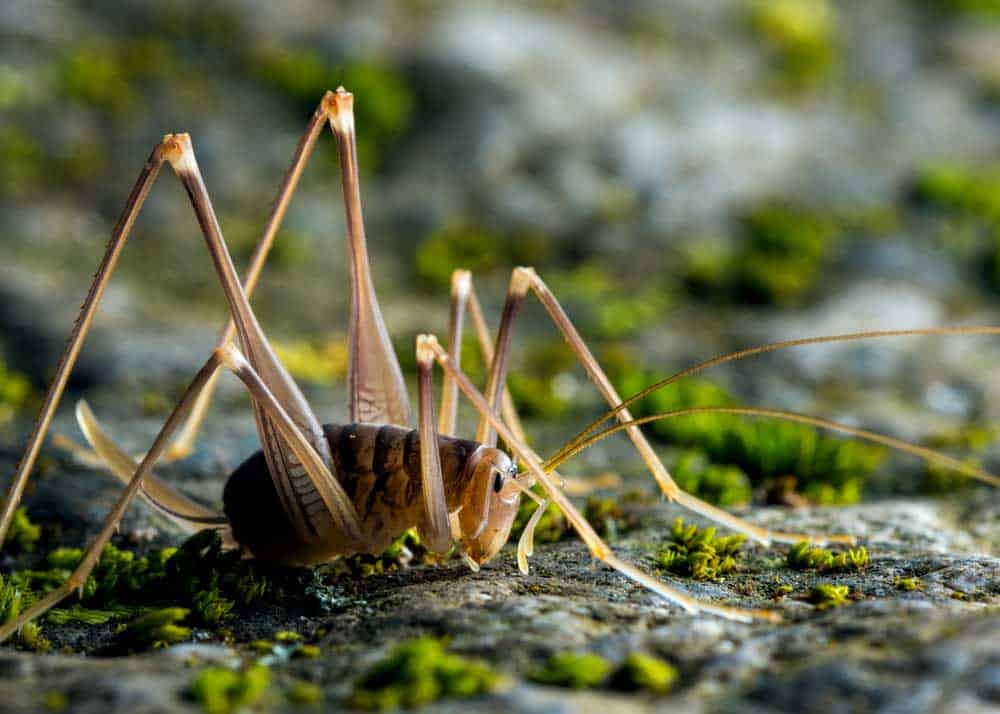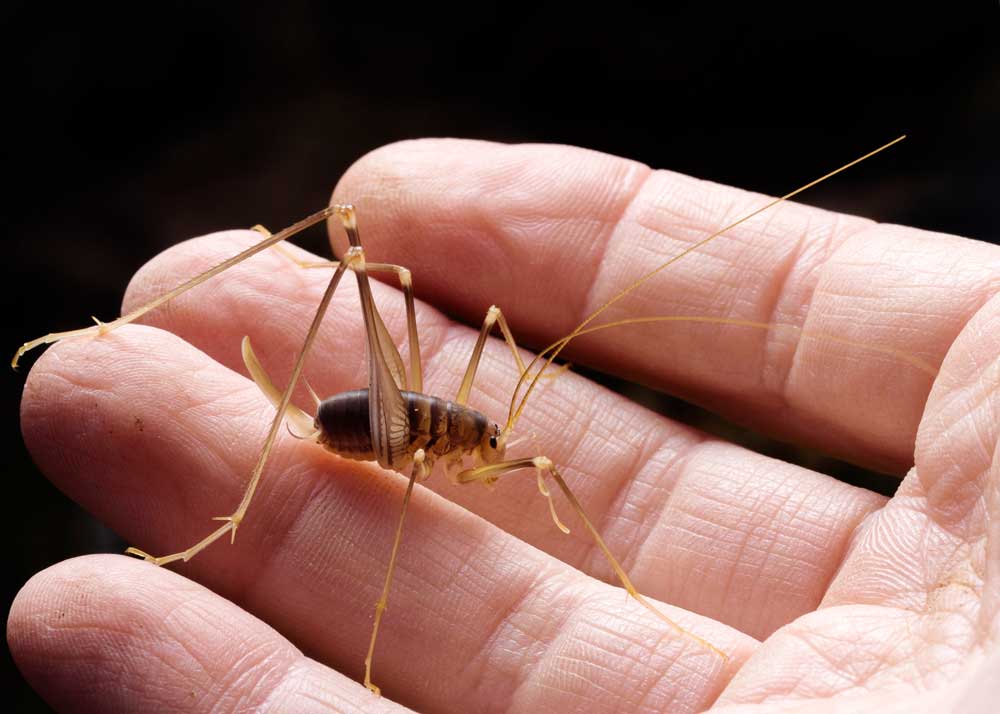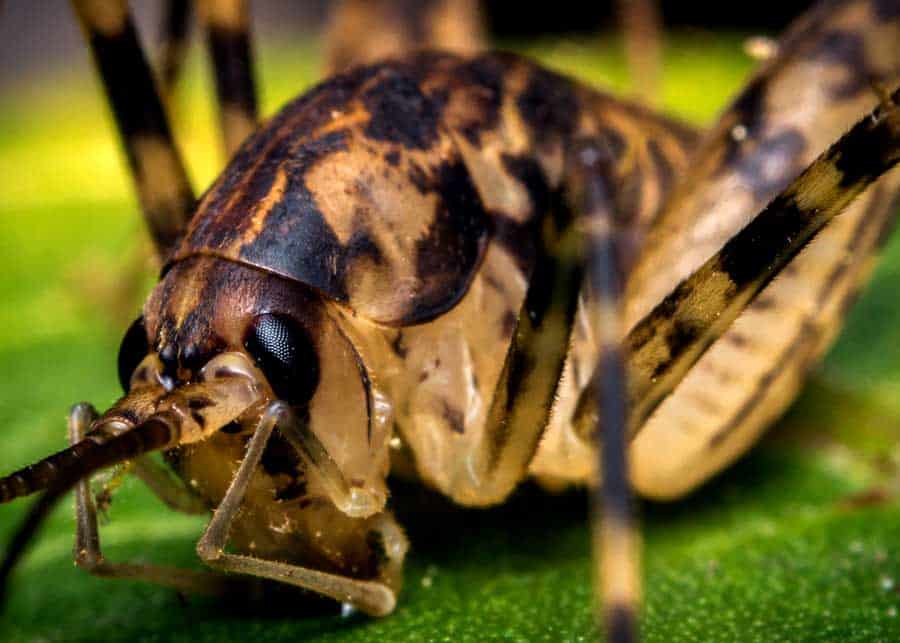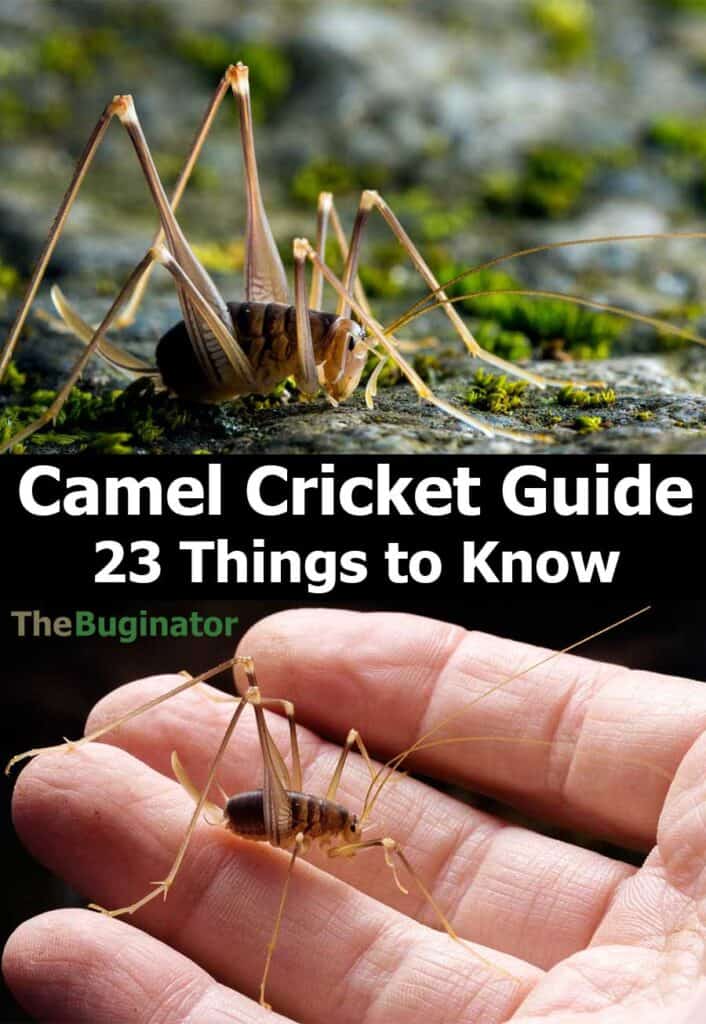Curious about camel crickets? These silent, harmless crickets are found around the world and in most moist habitats. They get their names from their appearance and traits: They have a camel-like hump (camel crickets) and spider-like legs (spider cricket) and like to live in caves (cave crickets).
In this post, you’ll learn all about camel crickets. You can find out more about these crickets as you plan a trip to their native habitats or if you think you have camel crickets near your home.

Table of Contents
Camel Cricket Overview
- Latin Name: Rhaphidophoridae
- Also known as Spider crickets, cave crickets, jumping crickets, land shrimp, sand treaders, and cave wētā
- Number of Species: 1100+ species of Rhaphidophoridae have been described
- Location: Worldwide
- Habitat: Wells, wood piles, damp places,
- Size: ½ to 1.5 inches long with antennae up to four inches long
- Diet: Plant matter, fungus, cloth, other bugs
- Physical Features: Long legs that come up and over their bodies and long antennae
- Lifespan: One to two years
Guide to Camel and Spider Crickets
Do camel crickets go by any other names?
Camel crickets go by several other names, including spider crickets and criders. As they often live in caves, some call them cave crickets.
You may hear people in Australia and similar regions refer to them as jumping crickets. This name comes from the fact that they jump high in the air when they are scared.
In Tasmania, Australia, and New Zealand they are often referred to as jumping or cave wētā.
What is the scientific classification of camel cricket?
- Kingdom: Animalia
- Phylum: Anthropoda
- Class: Insecta
- Order: Orthoptera
- Family: Rhaphidophoridae
More reading: Are Bugs and Insects the Same?
Where do camel crickets live?
Camel crickets live worldwide.
Some species are well known in Tasmania and New Zealand along with Australia.
You will also find them in different regions of the United States such as North Carolina and other southern states. They are most common east of the Mississippi River.
What do camel crickets look like?
These crickets get their name from camels because they both have a humpback. This back is unique in the insect world and allows both the long antennae and legs of the crickets to stand out.
They usually range in color from light brown to dark brown and have antennae that are longer than their bodies.
While adults can reach lengths of up to 1.5 inches, their antennae can grow to four inches. Camel crickets lack the wings that other types of crickets have.
Here’s a great photo of a camel cricket, in a hand for scale.

What are the habitats of camel crickets?
Camel crickets prefer places that are damp and dark. They often live outside in woodpiles and wells.
If you use mulch in your garden, you may find them living there.
The bugs can also come inside but will seek out places that have high humidity levels such as basements and laundry rooms along with crawl spaces, basements, and garages.
What do camel crickets eat?
People who had problems with these bugs found that they eat almost anything they find.
Camel crickets survive on natural food sources such as plant matter and fungus. If they cannot find a food source, they will eat other insects.
The crickets also eat any type of fabric or cloth, including clothing and curtains.
How do camel crickets breed?
Camel crickets often breed in the spring.
Some species, like the black-sided camel cricket, will breed in late summer, laying 2-30 eggs per season.
The female will then find a safe space to leave their eggs. They often prefer damp and sandy locations.
Females will leave the eggs alone until they hatch. Camel crickets can lay up to 100 eggs at a time.
What is their status?
Unlike other insects that are on the endangered list, camel crickets are safe.
They fall under the category of Least Concern, which shows that they exist in large numbers. There are more than 1,000 species of crickets that are part of this same group.
Some found small groups of these crickets in parts of both Asia and Europe, which shows they keep spreading.
Do camel crickets make noise?
Camel crickets don’t have the ability to chirp – or many any other noise. According to PestWorld, they don’t possess sound-producing organs.
While this is good news for your sleep, it also means that they will be harder to locate. Or even know that you have them in the house.
Scientists believe that the crickets’ antennae are so long because it allows them to feel and see in the dark conditions where they usually live.
How high can camel crickets jump?
One of the more impressive features of this cricket is that it can jump around three feet high, which is more than 40 times its height.
They usually only jump if they feel threatened.
Are spider crickets harmful?
You can check out our other articles to find out more about the dangers of these crickets and other bugs.
While camel crickets aren’t as harmful as other insects, they can potentially spread disease.
Can you keep a camel cricket as a pet?
Potentially, sure. A camel cricket could be a pet. Here’s more about keeping crickets.
Remember that they won’t form the type of bond that many people want to create with their pets.
How can camel crickets damage your home?
Camel crickets are a general nuisance that can do quite a bit of damage to your home. Some found that the bugs attacked the clothing they left outside to dry in the fresh air.
They will also use fabric in your home as a food source, which can result in them leaving holes in your clothing and curtains as well as your furniture.
Can you get rid of them without using chemicals?
There are a few different ways to treat your home and get rid of camel crickets without using harsh chemicals.
Start with caulk and weatherstripping to eliminate any holes or gaps around your home. These crickets need just a small gap to get inside. You can also use a dehumidifier to reduce humidity in your home and glue traps.
When the crickets walk across these traps, the glue traps them in place. There are some ways to build homemade traps, too.
Here are some live and lethal cricket traps to get rid of crickets in your home.
Where do the crickets live in nature?
In addition to living in your home and outside, camel crickets also live in nature.
They tend to stick to places that are damp because the dampness creates the fungus they use as a food source. You will commonly find them in caves and forests.
How long do camel crickets live?
Camel crickets have a lifespan of roughly one to two years. They only seek shelter in homes when they cannot survive outside. During dry spells, you may notice more living in your home.
The lifespan of the camel cricket drops when they move inside because they do not have as many resources.
Once the cricket dies, it decomposes and produces a strong scent that can attract other more insects.

Subfamiles and Genera of Camel Crickets
Here are some of the subfamilies and genera of camel crickets around the world.
Aemodogryllinae
- tribe Aemodogryllini Asia (Korea, Indochina, Russia, China), Europe
- tribe Diestramimini India, southern China, Indo-China
Ceuthophilinae
Cave crickets, camel crickets, and sand treaders: North America
- tribe Argyrtini
- tribe Ceuthophilini
- tribe Daihiniini
- tribe Hadenoecini
- tribe Pristoceuthophilini
Dolichopodainae
Cave crickets: southern Europe, western Asia
- Dolichopoda
Gammarotettiginae
- tribe Gammarotettigini
Macropathinae
tribe Macropathini Australia, Chile, New Zealand, Falkland Islands
Protroglophilinae
Rhaphidophorinae
- tribe Rhaphidophorini India, southern China, Japan, Indo-China, Malesia, Australasia
Troglophilinae
Cave crickets: Mediterranean
- Troglophilus
Tropidischiinae
Camel crickets: Canada
- Tropidischia
More reading: Do Slugs Feel Pain?

Learn more about other insects: Banana Spider and Brown Recluse Spider
Your Turn
Also known as cave crickets and spider crickets, camel crickets are small insects that eat fungus and other bugs as well as fabric and plants. Now that you know more about this species, you can identify any that you see around your home or as you travel.
- About the Author
- Latest Posts
Bryan Haines is a co-founder and writer at The Buginator. And is working to make it the best resource for taking back the outdoors from biting, stinging pests.
He also blogs about travel at Storyteller.Travel and photography at Storyteller Tech. Bryan is a partner at Storyteller Media, a publishing company he runs with his wife, Dena.

Sam
Thursday 30th of March 2023
I catch a couple camel crickets from my basement every time I see them. We keep them in a 3-gallon fish tank along with pill bugs and any other random critters we find. It has always been a joy to watch them hop around and grow!